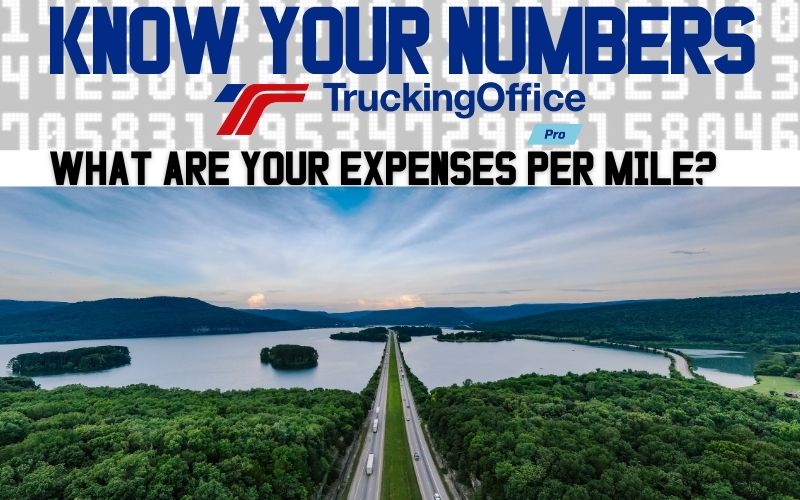Why do we think you need to know your expenses per mile? Isn’t that a little too deep into the details? Good questions. We don’t think it’s too deep because the future of any trucking business is based on keeping trucks on the road. So unless you’ve got a Star Trek Transporter set up to move freight, there’s no way to stay in business. TruckingOffice PRO is for trucking businesses, so yeah, we want you to know that expense per mile.
The hardest part of computing an expense per mile is probably trying to figure out trucking maintenance expenses per mile.
Trucking Maintenance Costs
Generally we look at maintenance as a whole, not as a cost per mile. Just like insurance might be considered a monthly, a quarterly, or an annual expense, maintenance can be examined the same way. Total up all the expenses and divide by the number of miles.
But… how to keep all that data in one place?
For some people, tracking expenses is a task they’d rather avoid at all costs. (Pun intended.) TruckingOffice PRO does do IFTA, IRP and invoices, but it also handles all your maintenance records.
Truckers have to track their maintenance. The DOT and FMCSA require regular maintenance to be sure our rigs are safe. So it makes sense that a trucking business software would track maintenance too. And if it’s tracking those things, it should be tracking the costs as well.
You know what you’re going to take care of on a regular basis. The daily inspection checklists are the best tool to keep your rig in the best possible condition.
Expected Maintenance Costs
Brakes. Tires. Oil changes.
There are several regular maintenance tasks that are scheduled based on time or on miles. Those are the primary expected maintenance expenses. Whether it’s by miles or time, by taking the time to schedule regular maintenance tasks has many benefits. You use the techs you want, at the location that’s most convenient, on your schedule.
That’s a huge benefit for you: you control the costs and when they come out of your pocket.
Unexpected Maintenance Costs
When it comes to unexpected maintenance costs, we think it’s pretty safe to say: the more you pay attention to taking care of your rig at home, the fewer on-the-road problems you’ll have. Sometimes it’s not a big expense, such as a bottle of window-washer fluid. Sometimes, it’s huge – like a new engine or transmission. That’s enough to push a trucker permanently off the road.
There’s no benefit to postponing maintenance like oil changes or transmission service. Money might be tight when it’s time to get those services taken care of, so prepare in advance by saving money in an emergency fund.
Those maintenance tasks are part of your expenses per mile.
Know Your Numbers: Expenses per Mile
Is knowing your expenses per mile important? Yes, because when you want to bid on a load, you need to know how much it costs you to haul a load.
When you track expenses, you’re tracking a lot of details from several different places:
- fuel cards
- credit cards
- bank accounts/checking accounts/debit accounts
That’s why you need a powerful trucking business software that focuses on the expenses that matter to your trucking business. Whether you’re the owner-operator or the fleet manager, knowing those expenses per mile are available immediately relieves you of worrying that you’re going to take a loss on a load.
TruckingOffice PRO works for either the owner-operator or the small fleet trucking business. Your expenses per truck are as easy to find as pressing a button on your computer or your phone screen. When the good loads on the load board are being snapped up as soon as they’re posted, you need that expenses per mile number immediately. TruckingOffice PRO provides that number on the Company Overview Report.
Get Your Company Overview Report
Our Company Overview Report shows
- Revenue: this number is generated based on the information entered under “Fees/charges” including primary fee, accessory fees, and fuel surcharges.
- Revenue Paid: generated based on the invoices-the payments entered.
- Expenses: includes driver pay, invoice advance, fuel expenses and truck expenses.
- Profit: Total revenue minus expenses
- Load Count: Number of Loads within that month.
- Revenue Per Load: an average of all revenue for that month.
- Miles: The total number of loaded and empty miles
- Miler per load: the average of all miles within that month per load
- Revenue Per Mile: The total revenue divided by the miles.
- Revenue Per Loaded Mile: Total revenue divided by loaded miles only
- Expense Per Mile: Total expenses divided by the total miles
- Expense Per Loaded Mile: Total expenses divided by loaded miles only.
- Profit per mile: Profit (revenue minus expenses) divided by the total miles.
- Profit Per Loaded Mile: Profit (revenue minus expenses) divided by Total loaded Mile
Don’t you want to know those numbers for your trucking company?
Give TruckingOffice PRO a free trial today so you can know these numbers for your trucking business.







Recent Comments